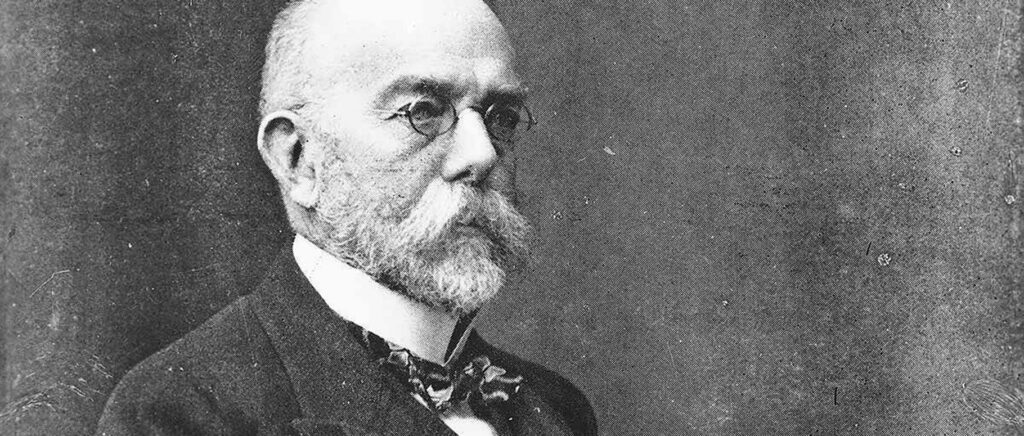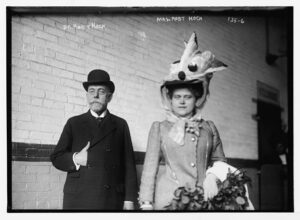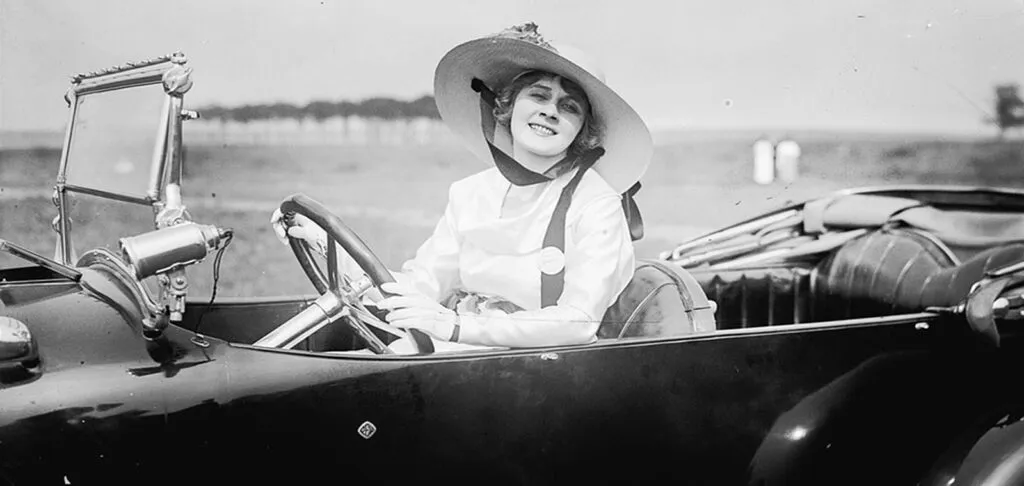
Love and disappointment
…This green lawn in the mountains is the favorite place of a serious boy with glasses and a quiet blue-eyed girl. Twelve-year-old Robert, son of the mountain counselor Koch, and Emmy, ten-year-old daughter of General Fratz, sit here for hours. Robert shares his dreams with her: he wants to become a ship’s doctor and travel the world. Sometimes he shows her what a fly wing or frog egg looks like under a magnifying glass. Emmy shudders with disgust, but hides her feelings. Robert’s quiet, calm voice puts Emmy to sleep. She’s bored: why go anywhere when it’s so nice here?
Robert was sure that Emmie was the only person who understood him. And Emmie had learned to sleep with her big blue eyes slightly covered with transparent eyelids, so that Robert could be sure she was engrossed in his story. Disappointment would come to Robert later. And he would experience it much more painfully than he would have done sitting on a lawn outside the town of Clausthal.
As long as the future pleases him. His parents, who dreamed of seeing their son as a merchant, gave in and allowed him to become a medical student at the University of Göttingen…. Fellow students laugh at the unsmiling young man in glasses and worn clothes. But Robert has no time to pay attention to ridicule. He sits in the library for hours on end, and leaves the preparatory room later than anyone else. And soon the news came out of the blue. This “dummy” had won the first prize for the scientific paper of the year!
On January 13, 1866, Robert Koch passes his doctoral examination and is graduated magna cum laude. He proposes to Emmy (her full name is Emmy Adelphine Josephine Fratz). The girl doesn’t cheat. It would be strange if their long-lasting friendship did not end in marriage….. When Robert tells his wife about traveling to distant lands, he suddenly encounters Emmy’s cold, uncomprehending gaze for the first time.
– Why should I ride on a ship, I’m not a sailor,” she replies. – I always dreamed of a beautiful house, nice children and a kind husband.
Robert was stunned. Emmy looked at him with big, innocent eyes, sure that she would get her way.

The “father” of cholera vibrio
The life of a doctor in the backwater town of Clausthal is boring and routine. But soon cholera struck. It was this misfortune that made the twenty-three-year-old Koch what he became. He doesn’t just treat patients, he studies disease. He dissects the corpses of the dead, clearly aware of the mortal danger he faces. But then Robert was too young to draw the right conclusions from what he saw under the microscope – a cluster of living things that looked like curved brackets. It would not be until eighteen years later that Koch would brilliantly prove that it was these “brackets” (he would call them cholera vibrio) that caused the dreaded disease.
Cholera ends as suddenly as it began, and Robert, in order to support a spoiled, accustomed to luxury wife and young daughter, again works as a doctor – in a backwater psychiatric clinic. Then he moves to a small town near Poznan. He is called to see patients at all hours of the day and night. Robert is so exhausted that he has no time or energy left for scientific work. But Emmy is happy: her income is growing, and the townspeople bow low to her and her husband.
Opening at the mouse cemetery
The people of the town of Wolstein, where the scientist became world famous, loved their doctor. You could turn to Herr Koch for anything, be it childbirth or a toothache. If it weren’t for his strange pastime of cutting up mice, you could say that he is an impeccable man. Koch does not know that he is good-naturedly laughed at – he works hard.
His first great discovery he made by accident: under the eyepiece of his microscope was a drop of blood from a sheep killed by anthrax. And he noticed that there were some bacilli and nodules. Koch is sure they cause disease, but it has to be proven. He creates a nutrient broth, an environment most similar to a living organism, grows the “blobs” artificially, and then buys up mice from all over the area and injects them with the disease.
Scientists would shudder to see the conditions in which the experiments are conducted: in a kitchen cubbyhole, without laboratory utensils, syringes, means of protection. He repeats his experiments over and over again, each time making sure that each bacillus turns into billions of bacilli and kills again. When the last dozen mice had been destroyed and the corner behind the curtain had become a mouse graveyard, he said to himself, “That’s it.” So Koch proved that germs do cause anthrax. There was no man on earth who could refute his experiments, so accurate, unmistakable and beautiful were they.
Preparation 271
Koch’s message became a sensation. True, the patriarchs of science were reluctant to squeeze him and let him on Olympus. But his work quickly became public. His wife still did not understand why Robert fiddles in the laboratory, but he has a like-minded woman. It is his daughter Gertrude, whose love for Koch has carried him through all the ups and downs of his difficult life. She washes the lab dishes, feeds the mice. Koch shares his thoughts with her.
Soon Koch and his family are transferred to Berlin and appointed to the high position of advisor to the government health department (correctly, advisor to the Imperial Health Department). He is given a laboratory, assistants and his passion to find the cause of the dreaded disease tuberculosis. A seventh of humanity dies from it. No one knows where it comes from, how it is contracted, or how to treat it.
Koch sits for hours over the microscope, inhaling dust particles of dried sputum of patients, not caring in the slightest that he may be infected. But the germ won’t budge! No tricks help. Koch dissects the lungs of the dead, makes hundreds, thousands of experiments, begins to doubt the correctness of the chosen path. His hands are blackened with paint – he hopes to see the elusive killer by painting him a bright color. One day, he comes up with a new– what’s the next. – paint formulation. Destroyed lung tissue cells are a matte brown color. But what’s that moving, shimmering in the moon’s blue? You can clearly see the slightly curved sticks. There they are, the most vicious of killers! The two hundred and seventy-first drug. Koch realizes that he has discovered the causative agent of tuberculosis. But, true to himself, he is in no hurry to report it. Only after proving everything to himself, he writes a work under the modest title “On the etiology of tuberculosis” and brings it to the Berlin Society of Scientific Medicine.
…Having finished his report, Koch waits. There’s a silence in the hall that frightens him. Suddenly, there was a roar of applause. This hall had never heard such applause before (at that time, every seventh person in Germany died of tuberculosis!). The same night, amazing news spread around the globe: Dr. Koch had found the germ that causes consumption. The next morning, the name of the German doctor was on the lips of all the doctors of the world.
In 1905, the microbiologist Heinrich Hermann Robert Koch (1843-910) was awarded the Nobel Prize in Physiology and Medicine for “research and discoveries concerning the treatment of tuberculosis”.
When a man cheats on himself
Recognition, fame and a sharp leap up the ladder played a fatal role. The very nature of Koch had two beginnings. One – a self-sacrificing, heroic ascetic. The other – an overbearing, power-hungry, aspiring to enrichment and honor, a cold, dry man. The scientist became arrogant and rude, did not tolerate objections. His disciples feared him and agreed with him in everything. Those who dared to argue, Koch ruthlessly expelled. But he still worked as enthusiastically as in his youth.
He and Emmy have been strangers for a long time. The only thing she asks him to do is attend her dinner parties. Sometimes he agrees. But… One day, Emmy invited guests over, prepared a delicious dinner. The conversation at the table is flowing at ease, and suddenly Koch, without saying a word, gets up and leaves. The guests look around, Emmy searches all over the house for her husband. He’s nowhere to be found! Koch’s assistant knows where to look – in the laboratory. And indeed, he finds Koch sitting at a microscope. He had long forgotten that his wife and guests were waiting for him at home.
Soon Koch plunges headlong into reclusiveness, just as he was in the years of his penniless youth. Only now there’s too much self-confidence. A scientist has a big idea: to find a cure for tuberculosis. The day comes when he is about to make his discovery public. He feels uneasy. He knows that it is too early to talk about the results, that there is a lot to check. But he is afraid that someone will beat him to it. On August 4, 1890, Robert Koch, the father of bacteriology, proclaimed to the world that he had found a cure for tuberculosis. He called it tuberculin.
Koch did not reveal the secret of his cure, but how could the doctors not believe a scientist whose impeccable self-importance was known to the whole world? A man who had risked his life hundreds of times before announcing the results of his research! Instantly, the newspapers ran articles with headlines like “No more consumption”. Robert Koch became a worldwide genius, and the fascination with tuberculin became a mass psychosis. Vials of the liquid were bought in unheard of quantities. Koch was showered with royal honors.
And suddenly there was a sobering realization. Sudden and terrible. There were reports of patients dying from pulmonary edema after tuberculin injections. Suddenly it turned out that there were no known cases of cure with this drug. A few months later, everyone became convinced that tuberculin not only did not cure consumption, but often destroyed the body, hastening death. Even yesterday, those who had prayed for Koch began to curse him.
Chasing a tsetse fly
Spit upon, ridiculed, Koch decides to leave Germany. And in this, the most difficult period of his life, he finds a family happiness he had never known before. After finally separating from Emmy, he meets a girl thirty years younger than himself. And in confusion he realizes that he loves her as he has never loved his wife. In 1893, at the age of fifty, Koch married the young actress Hedwig Freiburg.
“I have to go to Africa,” Koch told her and held his breath. After all, his life depended on her answer. And Hedwig didn’t even think about the fact that it was a test for her. She only asked what she should bring with her. That conversation shaped the future. For seventeen years, until Robert’s death, the couple were very happy….
In Africa, Koch studied sleeping sickness, which in a few years claimed more than a million lives. It starts with a headache, then weakness increases, the patient falls asleep where he is, and it is impossible to wake him up. A scientist discovered that the causative agent was carried by the tsetse fly. And found a cure. For Africans, his name became sacred.
Only seventeen years after Koch’s death, his students gave his favorite tuberculin a new life – the diagnostic era had begun. The Pirke reaction, known to every schoolchild, is based on the hypersensitivity of a person infected with tuberculosis to tuberculin. Even today, almost two hundred years later, it is the main diagnostic reaction in phthisiology. Great scientists are brilliant even in their mistakes….
Read also: The pandemic has caused TB deaths to rise for the first time in more than a decade
Наталия ДОЛИНА



